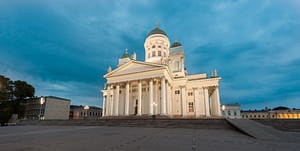Finland has taken a bold, creative lead in the highly competitive world of interior design. Search out ceramics and glassware (Arabia is famous), hand-woven articles, hand-carved wood, jaunty fashions, and rugs.
Textiles and jewelry also bear the distinctive stamp of Finland, and toy stores brim with educational toys for each stage of a child’s development. Souvenir possibilities include decorations made from reindeer skin, costumed dolls, baskets, and pungent berry liqueurs made from yellow cloudberries, cranberries, and Arctic brambleberries.
Most stores are open Monday to Friday 9am to 5pm and Saturday 9am to 2pm. Sometimes stores stay open until 4pm on Saturday, especially in the summer.
The major shopping neighborhoods are in the center of the city. They include Esplanadi, which offers the finest of Finnish design — but at high prices. Even if you don’t buy anything, it’s a delightful street for promenading in summer. Airline offices, banks, and travel agencies share the street with shops filled with the best of Finnish crafts, as well as a number of art galleries.
Esplanadi leads from the commercial heart of town all the way to the waterfront. Bordering the water is Market Square (Kauppatori), an open-air market selling produce, fish (both raw and ready-to-eat), handcrafted souvenirs, and some of the most magnificent berries (including glorious blackberries from the Finnish forest) we’ve ever seen. Most of the vendors are in place during daylight hours, between April and October, Monday to Saturday.
The other main shopping section is called simply Central, beginning at Esplanadi and extending to the famous Helsinki Railway Station. Many of the big names in Finnish shopping are here, none more notable than the Stockmann department store. Many shopping complexes are also in this district, including the Forum. One of the main shopping streets here is Aleksanterinkatu, which runs parallel to Esplanadi, stretching from the harbor to Mannerheimintie.
Other shopping streets, all in the center, include Iso Roobertinkatu and Bulevardi, off Esplanadi. Bulevardi, starting at the Klaus Kurki Hotel, winds its way to the water. Two recent additions to the shopping scene include Kamppi, or the Kamppi Shopping Mall, in the heart of the city, and a smaller but choice competitor Hakkoniemin Kauppahalli. The former devotes four of its floors to shops; the remainder — especially the lower floors — are the domain of the city’s new bus station. The latter contains about 20 shops, most of them stylish and upscale.
It has been argued that a sense of the Finnish nation was assisted during its birth process by staggeringly brilliant designers and architects (Saarinen, among others), who brought a new definition of utilitarianism and modernism to the world at large. Conveniently, the Helsinki Tourist Office provides a “Design District Helsinki” map. It lays out the location, within a relatively condensed neighborhood, of at least 100 shops, each selling objects (housewares, clothing stores, jewelry) that were influenced by the nation’s 20th-century tradition of brilliant modernist designs in every imaginable arena.

